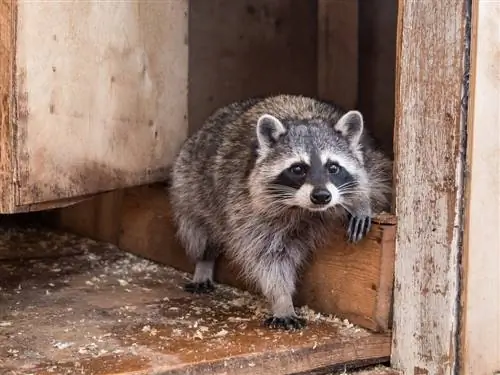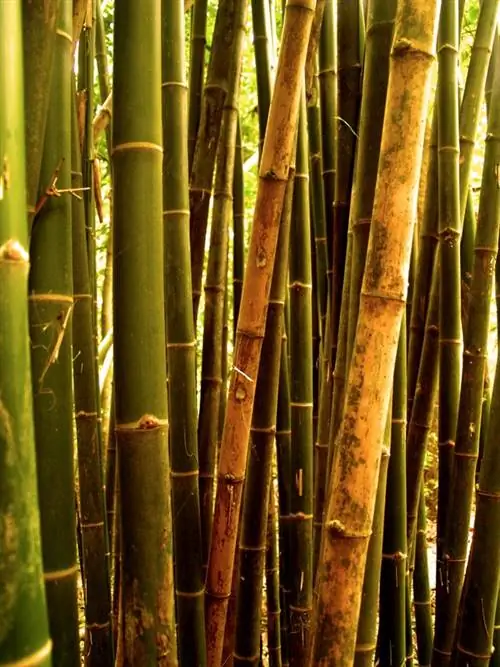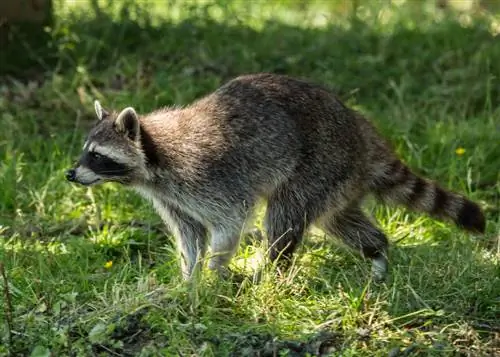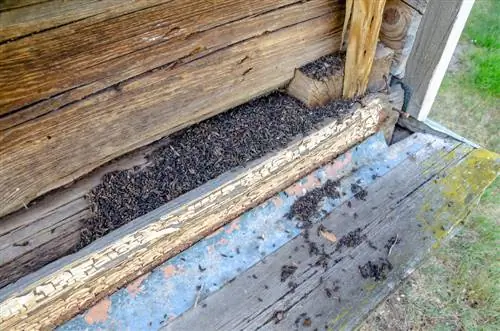- Author admin [email protected].
- Public 2023-12-26 14:17.
- Last modified 2025-06-01 06:02.
Raccoons are increasingly found in residential areas and cause major damage to gardens and attics. Their droppings can also be found everywhere, as the animals defecate in regular communal toilets. This article is about how to identify and properly remove raccoon droppings.
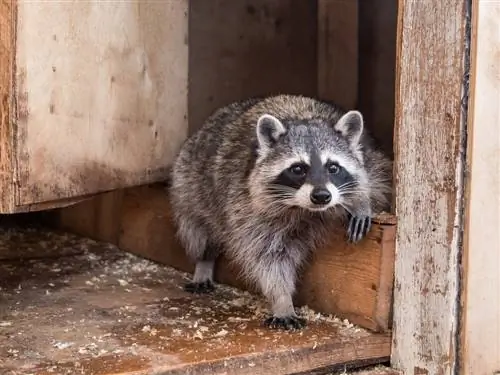
How do you identify and clean up raccoon poop?
Raccoon droppings can be recognized by raised deposits, different shades of brown, lots of hair and seasonal food remains. Protective clothing is important when cleaning up as the feces can contain pathogens. To keep raccoons away, secure trash cans and close home entrances.
- Raccoons always use the same defecation places, which are called latrines. Other raccoons from the same area also defecate here.
- Raccoon droppings always look different depending on the season and food. However, you can distinguish it from other animal droppings by certain features.
- In addition to descriptions, include photos for identification.
- Wear protective clothing when removing as raccoon feces can be contaminated with roundworms, their eggs and other pathogens.
- Make it as uncomfortable as possible for the raccoons in the garden. Above all, close garbage cans and compost containers.
Raccoons create community toilets
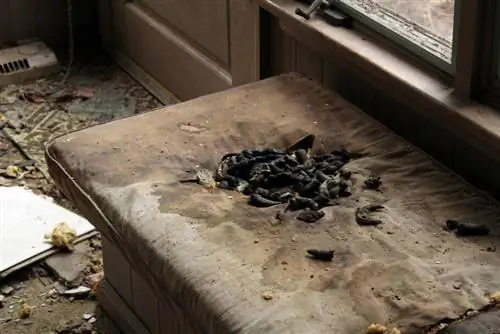
Raccoons always go to the toilet in the same place
It is typical for raccoons to create so-called latrines. These are communal toilets that several raccoons in an area use together. This means that if you find raccoon poop in the attic or yard, it's more likely to be larger accumulations of feces - and it doesn't just come from one animal.
Incidentally, these latrines are not only visited by a family of raccoons, but also by other animals that do not belong to the same group. The reason for this behavior is simply communication, because raccoons exchange information about their remains and thus find out who else is currently nearby. That's why places that were once chosen as latrines are used again and again - thorough cleaning and odor removal is therefore extremely important, otherwise you won't get rid of the problem.
Raccoon droppings always in elevated places
An important distinguishing feature between raccoon droppings and other animal droppings is the fact that the small bears always deposit their droppings in elevated places. For example, the droppings in the garden can be found on branches or boards, in the attic or in the basement, possibly on cupboards or shelves.
Identifying raccoon droppings - typical features and differences
The unequivocal identification of raccoon feces is also difficult because the appearance of the feces can change significantly depending on the composition of the food. Raccoons are omnivores that eat both animal and plant foods and also like to forage for food in human waste. As a result, raccoon feces contain different admixtures depending on the season and the food supply, such as: E.g. cherry and other fruit stones, remains of sunflower seeds and nut shells, beetle shells, etc.
A reddish color to the feces suggests that the raccoon in question has eaten berries. The animals really like the fruits of the yew tree, which are poisonous to humans; they eat them without any problem and do not suffer from any symptoms of poisoning. So if the droppings are pink and there are seed kernels in them (raccoons don't chew up yew seeds), then it is almost certainly raccoon droppings.
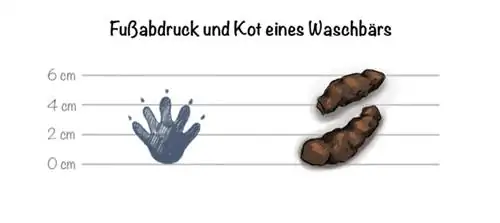
Otherwise you can recognize raccoon droppings by these features:
- very similar in shape and size to the feces of small dogs
- various shades of brown possible, depending on the feed composition
- contains a lot of hair (gray-white colors), as the animals clean themselves thoroughly with their tongue
- Seasonally dependent food leftovers, including devoured, indigestible leftovers from household waste
- pungent smell
If the characteristic paw prints are also found around the feces, then the case is actually clear. If you suspect that some raccoons have set up a latrine in your area, it is best to sprinkle flour over a large area in the area in question - there you can clearly see from the paw prints whether a raccoon is really up to mischief in your area.
Raccoons mostly cause mischief in settlements and gardens that are near forests. Dachshunds, foxes and other animal companions often come here looking for food. If you are unsure about identifying the feces, the following table may help you determine the culprit.
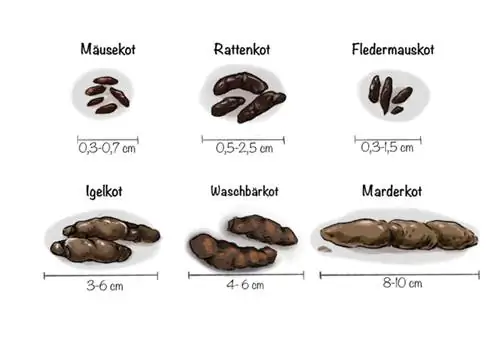
| animal species | Storage location | Shape | Consistency | Coloring | Special features |
|---|---|---|---|---|---|
| Badger | mostly in holes in the ground, often under trees | cylindrical | dry or mushy, depending on the composition of the food, contains indigestible food residues | different shades of brown, depending on the food eaten | rough and uneven surface |
| Squirrel | practically everywhere, no preferred defecation locations | roll-shaped, small | firm and rather dry, usually contains food residue | dark brown to black | odorless |
| Fox | preferably in elevated places, e.g. E.g. mounds of earth, on the edges of beds or on stones | “Sausage” up to ten centimeters long and up to two centimeters thick | solid, often contains leftover food | gray to black | Caution: may contain fox tapeworm eggs! |
| Hedgehog | practically everywhere, defecates while running | roll-shaped, pointed end | often contains leftover food | black, shiny | does not form “heaps”, spreads over larger areas |
| Cat | Feces are buried in soft, loose soil or sand | sausage-shaped, often spiral | contains no visible plant food residues | dark gray to black | intense, very unpleasant smell |
| Marten | deposits feces directly on the ground | sausage-shaped, often spiral, up to ten centimeters long and two centimeters thick | solid, visible food residue | dark gray to black | intense, very unpleasant smell |
Note: Larger accumulations of up to three centimeters long, slightly curved “sausages” in the attic or basement can also be an indication of an acute rat infestation. Rat droppings smell intensely and unpleasantly of ammonia.
Removing raccoon droppings
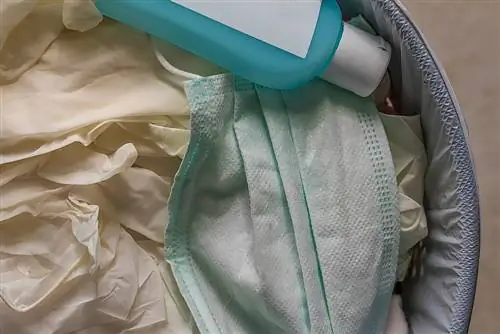
Raccoon droppings should be removed with gloves and a mask
Of course, the raccoon droppings you find can't just be left lying in the attic or in the garden - the smell will almost certainly attract other small bears from the area, who will happily meet you. In addition, the feces are contaminated with pathogens and parasites and should therefore be removed for hygiene reasons. When removing feces, proceed as follows:
- Wear old clothing, overshoes, mouth and nose protection and disposable gloves.
- Sweep up the raccoon droppings completely with a shovel or similar.
- Put the feces in a plastic bag and seal it tightly.
- Then, throw both the filled plastic bag and the disposable protective clothing in the trash.
- This also applies to rags etc. used during cleaning.
- Treat the cleaned areas with a disinfectant spray.
- Wash your clothes thoroughly at 60°C.
- Clean and disinfect the shovel and other equipment used.
Even after thoroughly removing the raccoon droppings, the unpleasant smell still hasn't gone away. You can combat this with chemical cleaning agents or vinegar, which you apply generously to the floor and allow it to take effect. If you like, you can also cover up the smell with scent fresheners sprayed into the air (€19.00 on Amazon). These measures also have the purpose of making the latrine unrecognizable to the raccoons - so the animals have to look for another place, which hopefully is not on your property.
Excursus
Are roundworms in raccoon feces dangerous to people and pets?
Raccoon feces can contain thousands of raccoon roundworm (Baylisascaris procyonis) eggs, which are harmless on their own. However, roundworms can develop from this and live in the small intestine of infected animals. Since humans and larger mammals are false hosts for this species, roundworms cannot develop in the event of an infection (e.g. through contact with infected raccoon feces) - these rely on the raccoon, to which they in turn return via intermediate hosts such as rodents and birds. But be careful: Raccoon roundworms have occasionally been detected in dogs.
Repel raccoons
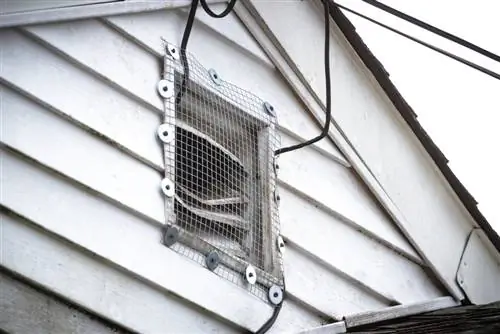
All entrances to the house should be well locked
“The raccoon is a lively, handsome boy who is very pleasing due to his great activity and mobility.” (Alfred Brehm)
So that the pests don't keep visiting you, you should make your house as inaccessible as possible and make the food on offer in the garden less tempting. These measures will help:
- Dispose of leftover food only in tightly lockable garbage cans.
- This applies especially to rich foods such as meat, fish and dairy products.
- These are particularly popular with raccoons.
- Do not put garbage cans (especially the yellow bag) outside until immediately before collection.
- Clean trash cans regularly.
- Weigh down ceilings with a large stone.
- If you compost, it is best to use a well-sealed compost container.
- Do not leave cat or other animal food on the terrace or in the garden.
- Raccoons also love to eat hedgehog food.
By the way, the little bears are excellent climbers and can get into the house in many different ways. To block their path, these measures help:
- Close cat flaps.
- Remove facade greenery or climbing plants on the house wall or refrain from planting them.
- Prune high hedges close to the house.
- Also branches of trees etc. that reach towards the house.
- Provide downpipes and gutters with metal sleeves.
- Always close loopholes in the house and on the roof well, e.g. E.g. shifted roof tiles.
Of course, you shouldn't feed the cute animals - this way you will only attract them instead of driving them away. Word quickly gets around in raccoon circles about where there is something tasty to eat!
What you should definitely not do
Some people lose patience in the face of overturned garbage cans, torn up compost heaps, plundered fruit trees and dirty attics and try to get rid of the little bears with final solutions. This is understandable, but you should still adhere to existing laws - the pen alties if you get caught are immense! These methods are strictly prohibited:
- Raccoons must not be killed with poison.
- Setting up traps is also prohibited without a fishing permit.
- This also applies to live traps if you then want to kill the raccoon caught in it or release it somewhere further away.
- Live traps are only permitted if the animal is released again immediately behind the property line.
- After all, it could be a mother raccoon whose young animals would now have to starve.
- Never set your dog on a raccoon - the animals are aggressive and very defensive in the event of an attack. If in doubt, your dog is more likely to lose out.
Don't forget that raccoons are wild animals that can defend themselves very painfully if necessary!
Excursus
Why are the cute raccoons a problem in Germany?
No question: Raccoons are cute animals and have established themselves in Germany over the decades. However, the predators are multiplying rapidly due to a lack of enemies - hunters kill more than 100,000 individuals every year and yet the known populations are increasing. This becomes a problem for many bird species, but also for bats and pond turtles, because raccoons are effective nest robbers and therefore contribute significantly to the endangerment of these species.

Frequently asked questions
Where does the raccoon come from?
The raccoon is originally native to North America. Since the middle of the last century it has begun its triumphal march through Central Europe after animals were abandoned or escaped from game reserves and fur farms. By the way, the raccoon dog (also called Enok, Nyctereutes procyonoides) is not originally native to Central Europe. The species, which comes from Asia, settled here after animals escaped from fur farms.
Where do raccoons stay during the day?
Raccoons are generally active at night and at dusk (with the exception of some populations, such as in Thuringia). During the day, the small bears sleep hidden in tree hollows or similarly elevated places. The animals occur in regions with deciduous and mixed forests and prefer to be near water.
Are raccoons dangerous?
The small bears - just like martens, rats or voles - can become a real pest in the garden by causing serious damage. The cute raccoons should be treated with caution, especially when they are raising young: many mother raccoons have attacked and bitten people to protect their offspring. What is particularly problematic, however, is the fact that the animals' feces contain dangerous pathogens. These not only infect people, but also pets, for example with the dreaded distemper.
Do raccoons kill chickens too?
In fact, raccoons have been observed killing and eating chickens. After all, they are omnivores, for whom, just like foxes, the poultry is a tasty and therefore welcome meal.
What sounds do raccoons make?
Raccoons make a variety of sounds that these sociable animals use to communicate with each other. The little bears growl, cackle or screech.
Are raccoons protected?
No, unlike many other wild animals, the raccoon is not protected, but is subject to hunting law. However, this does not mean that you can kill the animals at will (e.g. poison them), only a hunter or, within residential areas, a pest controller can do that. An exemption is also required.
Tip
Bulky waste, building materials or piles of boards left on the property also have a magical attraction for raccoons, after all, the animals like to use these places to hide and sleep.

